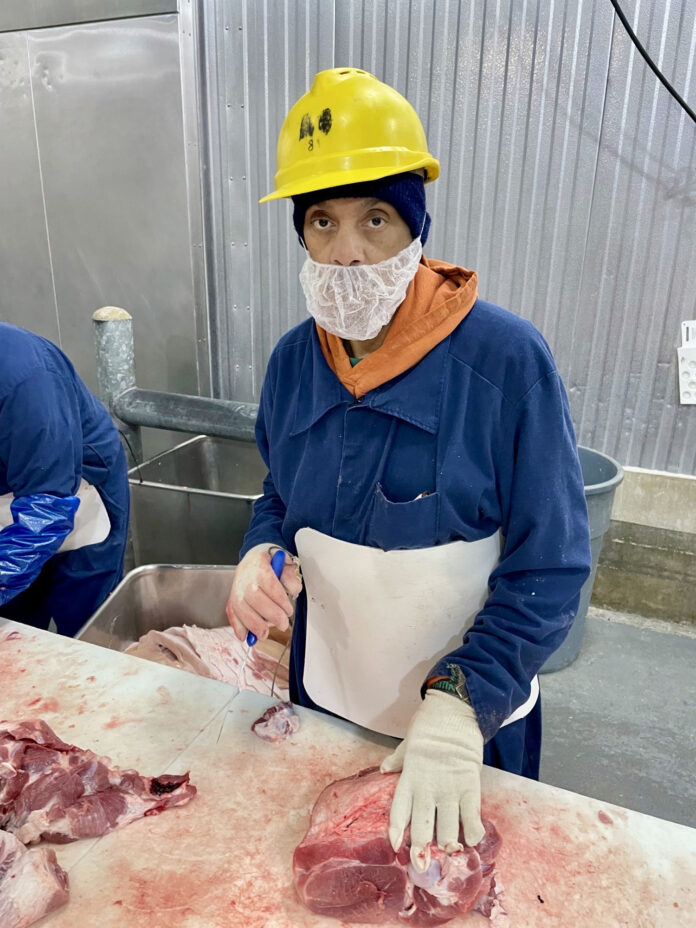
ORIENT, Ohio — With the skills he’s learning at the Pickaway Correctional Institution’s Meat Processing Career Center, Aaron Chiles expects to be able to find work no matter where he travels once he is released.
“Not only am I acquiring skills I can take home with me, these skills travel, worldwide actually,” he said, during an interview at the center. “I feel pretty good about that. It gives me a little bit to look forward to.”
Chiles is one of around 65 incarcerated men working and receiving training through the Meat Processing Career Center.
Job skills
One of the goals of the program is to give participants experience they can use to get a job once they are released, said Ann King, chief of Ohio Penal Industries for the Ohio Department of Rehabilitation and Correction, “We target those who are leaving within five years.”
With training and guidance from the career center staff, the incarcerated workers handle everything from the kill floor through packaging and labeling of retail cuts of meat. For security, cutting tools are locked away at the end of every shift, but otherwise, the plant operates much like any commercial processing plant.
The training program is hard work, Chiles said, and the staff expects participants to take the job seriously.
“Like in the real world, they’re going to hold you accountable,” he said.
Chiles transferred to the institution last May after he was selected for the training program. Before that, “I hadn’t even carved a turkey on Thanksgiving Day,” he said,
Like Chiles, Christopher Kretzer had never done any meat cutting before entering the training program. He had once worked in heating and cooling. Now, he’s looking toward a career in meat processing when he is released. In the meantime, he’s benefitting from the time he spends working and training at the meat plant.
“It’s been a good experience for me. There’s a lot of good guys out here,” he said. “They treat you like a normal person out here.”

Selection process
William Bierbaugh, manager of the Meat Processing Career Center, explained that incarcerated individuals must apply to participate in the meat processing program.
They’re expected to earn a high school diploma or GED first, and they are vetted carefully because of the equipment they have access to in the center. After being accepted into the program, participants start a basic training program to learn about the tools and processes used throughout the facility. Then, after a three-month probationary period they can start a 6,000-hour apprenticeship program.
Besides the meat cutting apprenticeship program, the center has an equipment maintenance apprenticeship program. Participants can also take classes for additional certifications. For instance, Ohio State worked with the career center to offer a HACCP (Hazard Analysis Critical Control Point) certification class and Sinclair College offered training for Servsafe Certification, which covers food safely and sanitation.
The career center also helps link participants with employers when they’re released.
This past July, the center lined up a meat processing job for a man released after being incarcerated for 47 years, Bierbaugh said. “The place he went, they were very impressed with his knowledge.”
Meat processing history
The meat processing facilities at the Pickaway Correctional Institution were constructed in 2005 to process beef produced on farms operated by the Ohio Department of Rehabilitation and Correction. When those farms were closed in 2016, the meat processing facility continued to operate, handling cattle and hogs from outside businesses and individuals.
The facility is U.S. Department of Agriculture inspected and has a capacity to handle 75 to 80 hogs in a day or 35 to 40 cattle. The Meat Processing Career Center has been processing hogs and cattle for individuals, meat markets, private partnerships, local companies and area restaurants, explained Travis Hall, a regional industry manager with OPI.
One family company brought the center 200 beef cattle between June and the end of November last year. The center is also working with Saddleberk Farms to process hogs and make sausages sold through Kroger stores and other retailers.
Starting in January, the center will be processing 24 beef cattle and 40 hogs each week to supply Ohio food banks.
OPI programs
The meat processing facility is one of 30 employment and training programs operated by OPI, King said. OPI programs produce a wide variety of products including toilet paper, glasses, dentures, furniture, clothing and even the salt trucks used by the Ohio Department of Transportation.
The OPI workforce is made up of about 1,100 incarcerated adults at 13 correctional institutions. Participants are paid wages and can also qualify for earned credit off the end of their sentences.
The OPI programs are entirely self-supporting and do not rely on tax dollars for workforce salaries, staff salaries, raw materials or other operation expenses, King said. The Ohio Revised Code requires the state to purchase from OPI first before going to outside suppliers. OPI products and services are marketed to the public as well.
More information on the Meat Processing Career Center is available online at opi.ohio.gov/services/catalog/meat-processing-career-center.











